ENTER YOUR EMAIL TO RECEIVE OUR WEEKLY NEWSLETTER
End-of-Winter Skin Soothers and Rechargers
Jump-start spring with remedies for parched, slack, confused New York City winter skin.
By Linda Dyett
Nor’easters hurling icy snow…35 degrees one day…70 the next: The East Coast winter of our skincare discontent is nearly over, leaving us with dull, sluggish, flaky, dried-out, itchy, muddled skin. So I contacted Laurel Naversen Geraghty, M.D., a dermatologist who is intimate with New York City weather. She spent 10 years here—first as a beauty writer and Glamour editor, then attending the NYU School of Medicine. When you live that long in this city, she proposes, “you always consider yourself a New Yorker, right?” Dr. Geraghty has since moved back to her home state, Oregon, and joined her father’s dermatology practice in Medford. But she remains keenly aware of the New York climate at its most bitter, and of cosmetics aesthetics. Below, she offers her suggestions and insights for a variety of eminently affordable products that will help take the torpor out of our skin as it heads into spring.
Let’s start with the body.
According to Dr. Geraghty, what you need for restoring smooth, hydrated arms and legs—and also abs and derriere—isn’t luxury-level; it’s available at your nearest Duane Reade or CVS, and, of course, via Amazon. She rates “ointments, which prevent water loss, as the most effective moisturizers overall. But many people—understandably—don’t like the feel of goo [i.e., Vaseline] on the skin.” Instead, she recommends: [Note: prices below may vary slightly day to day and store to store.]
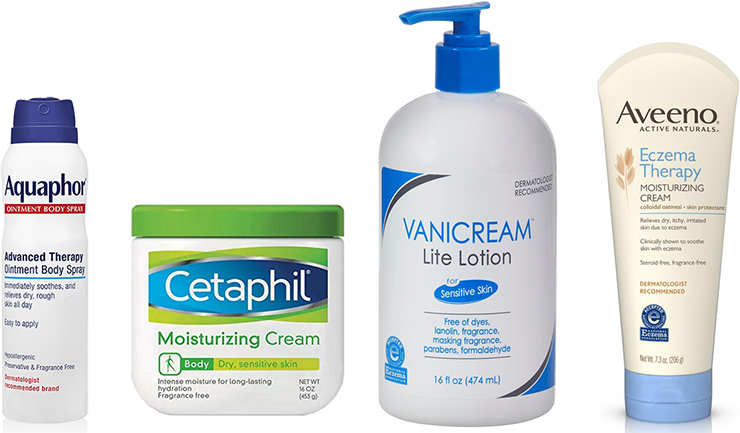
Aquaphor Advanced Therapy Ointment Body Spray, 3.7 oz., $8 at Target. This one, Dr. Geraghty says, “delivers a fine hydrating mist to protect and soothe dry skin.”
“One rung down from ointments on the moisturizing ladder,” she continues, are thick creams, “which have the benefit of being non-greasy.” Several she praises:
Cetaphil-Moisturizing-Cream, 16 oz., $18 at Target.
Vanicream Skin Cream with Pump Dispenser, 16 oz. Lite lotion: $12, Regular lotion: $13.43 on Amazon. Or Target.
Aveeno Eczema Therapy Moisturizing Cream, 7.3 oz., $7 at Target. This one contains soothing colloidal oatmeal, known to seal in moisture.
As for body lotions, Dr. Geraghty finds them less hydrating, but “for overall roughness, flaking or overt alligator skin,” she recommends three that contain ammonium lactate—a blend of dead-skin-sloughing lactic acid and pH-adjusting ammonium hydroxide:
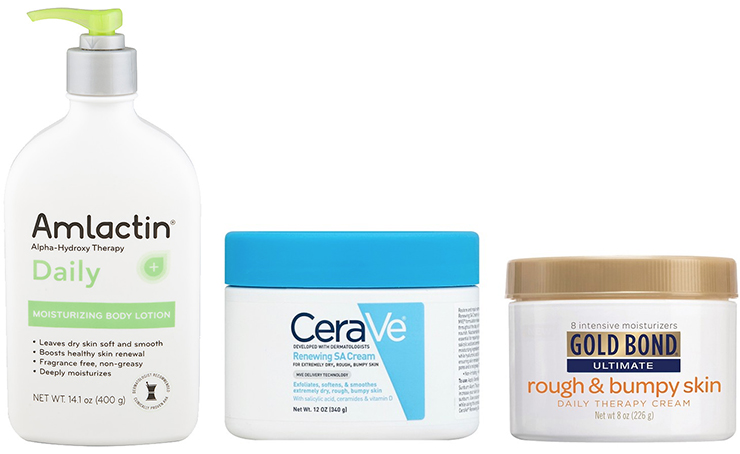
AmLactin Moisturizing Alpha-Hydroxy Therapy Moisturizing Body Lotion, 14.1 oz., $12.19 on Amazon. Or coupons are available on the AmLactin website.
CeraVe Moisturizing SA Cream for Rough & Bumpy Skin, 12 oz., $15.50 at Target.
Gold Bond Ultimate Rough and Bumpy Skin Daily Therapy Cream, 8 oz., $8.50 at Target.
. . . . . . . . . . . .
Moving onto the face.
Here, I’ve found a handful of new-generation home-use anti-aging products that seriously rev up the complexion. They’re mostly from upstart indie cosmetics companies you might not have heard of. Millennials have been quick to glom onto these rejuvenation brands and treatments for preventive care. But the fact is…their benefits are even better suited to us, their elders.
As Dr. Geraghty points out, none of these cosmetics are essential for skin health and radiance the way sunscreen is, and none will do what prescription retinoids or Botox do for minimizing wrinkles. But used consistently, they’re formulated so well that they have a good shot at plumping up and brightening the skin, at least into the next day. Use them regularly and the benefits continue. Consider the rundown that follows as an introduction, with Dr. Geraghty’s comments on the products or their ingredients. And definitely try other offerings from the same brands.
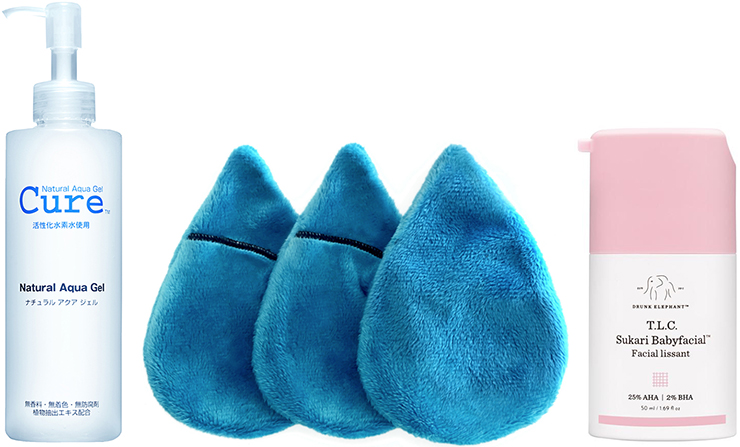
Cure Natural Aqua Gel, $38. at Cure Aqua Gel. There’s a novel exfoliation technique that originated in Japan and is rapidly winning aficionados in the U.S. Known as a gel peel (or peeling gel), it involves a syrupy, slippery substance whose key ingredients—acrylates (inert chemical compounds used in plastics and resins) or cellulose (from plant cells)—function as gentler alternatives to scrubbing grains. These gels typically also contain botanicals intended to boost the peeling process and soothe the skin.
The first of this breed, Cure Natural Aqua Gel, is made in Japan, where a bottle is reportedly sold every 12 seconds. Dr. Geraghty notes that it contains glycerin, “a humectant that can help trap moisture against the skin. Glycerin has the potential to leave behind a sticky feel—especially if you’re in a humid environment, because it can actually draw moisture out of the air and trap it onto the skin’s surface!”
How to apply? Dab a small amount onto a freshly cleansed discrete area—nose …cheeks … forehead. Don’t let it dry. Instead, wait until it just begins to get tacky—anywhere from 10 seconds to several minutes. Then, using circular motions with the fingertips or a washcloth, rub into the skin for about 30 seconds. The slippery texture seems to guarantee that you can’t rub too hard. You’ll notice tiny flecks emerging, which some claim are beads of dead skin cells. More likely, agrees Dr. Geraghty, they’re acrylate residue. Repeat on other areas of your face. If you seek an even-toned, foundation-free complexion, with diminished-looking pores, this may do it. Try it on your elbows too. Many are tempted to use these gels every day, but the usual advice is two or three times a week.
The Makeup Mitty, 3-pack, $38.50 on TakeMyFaceOff.com. For a softer touch than your fingertips, rub off the peeling gel with this plush, deep-pile, quick-drying, patent-pending washcloth alternative, developed by a traveling classical musician. It’s also a terrific makeup remover.
T.L.C. Sukari Babyfacial, $80 at Drunk Elephant.com. Meanwhile, traditional masks—the kind that are plied onto the skin and left uncovered—have lately been acquiring high-powered ingredient mixes. One that’s got a devoted following is the T.L.C. Sukari Babyfacial, from Drunk Elephant, a cult skincare company, also in Texas (evidently a hotbed of innovative indie cosmetics companies). Its homemaker-founder started the business in a determined effort to offer smart biocompatible ingredients at reasonable prices. She named it Drunk Elephant—referencing the myth that elephants get intoxicated after eating the tasty root of the African marula tree. (This rapidly penetrating oil, which may help with skin elasticity, is found in many of the company’s products.)
The T.L.C. mask is loaded with potent rejuvenator acids: for starters, 25 percent alpha hydroxy acids (glycolic…tartaric…lactic…citric) to soften fine lines and wrinkles, lead to smoother skin, even out mottled pigmentation, and ramp up collagen and elastin,” says Dr. Geraghty. Plus, it’s got 2 percent anti-inflammatory salicylic acid (a relative of aspirin), “effective at removing natural lipids that can contribute to clogged pores.” All in all…a high-powered mix you’d expect would irritate the skin. Instead, it leaves a warm, slightly revved-up sensation. That’s thanks to niacinamide, mixed in to “enhance cell turnover, reduce facial redness and improve skin tone,” adds Dr. Geraghty, who recommends this ingredient for rosacea and sensitive skin.
“I love it,” she says, “when companies like Drunk Elephant develop balanced products that can allow the ingredients to do their job, yet formulate them with skin soothers and moisturizers to help minimize those potential side effects.”
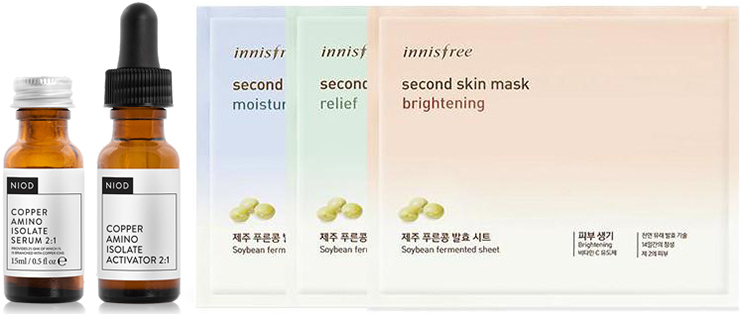
Copper Amino Isolate Serum 2:1 by NIOD.com, $60. Deciem, a four-year old Canadian umbrella cosmetics supplier, bills itself as “The Abnormal Beauty Company” and seems to be breaking all the cosmetics industry rules. Its founder-CEO, a former computer programmer who writes all the promotional materials, comes across as outspoken and blunt. One of its product lines, The Ordinary, offers high-performance potions for under $10 and has a devoted following. Deciem’s popularity hasn’t escaped the attention of the Estée Lauder Companies, which now owns a minority share; its president, Fabricio Freda, cites this upstart’s “unique business model” and “global growth aspirations.” Deciem stores have already opened stores in several countries. In New York City, it has branches in Nolita and Brooklyn, with more planned for later this year.
I’d been hearing good things about Copper Amino Isolate Serum, one of the products in Deciem’s advanced treatment line, NIOD (Non-Invasive Options in Dermal Science). But I was doubtful—and wary—of the pretentious scientific overkill in this and other Deciem product names and descriptions. Now…I’m sold on this serum, which left my complexion instantly and noticeably smoother, firmer, plumper and more even-toned—an effect that lasted several days. Dr. Geraghty explains that the peptides (amino acid compounds) in it “ramp up production of collagen, elastin and water-holding molecules that give the skin its plump, youthful volume and help minimize fine lines and wrinkles.”
Fermented Soybean Bio Cellulose Mask, $6 at Innisfree.com. Even if you haven’t tried them yet, you’ve probably noticed foil-wrapped sheet masks at drugstore and supermarket checkout counters. They’re everywhere these days, and like a lot of 21st century cosmetic innovations, they originated in Korea—where women reportedly affix one of these moisture-laden innovations (made of a sturdy but permeable, non-woven fabric) to their face every night. What’s special about them? They adhere to the skin, where they’re meant to stay for 20 minutes. And though they’re drenched with serums, they don’t, amazingly, drip. Most women lie down while wearing these masks—but that’s not absolutely necessary. As an experiment, I wore them while sitting up, typing and knitting, and they stayed put.
Some sheet masks are for parched skin, some for wrinkles, some for sagging, some for dark spots. Dr. Geraghty “can’t say they’re essential. They’re not backed by any significant scientific evidence.” But, she continues, “doctors know that occlusion—simply trapping any topical ingredient against the skin with something tight or plastic-y—can help to increase that ingredient’s strength and efficacy. So sheet masks do make some inherent scientific sense, and some of them may be found to offer benefits with consistent use.” Once the mask is removed, it may also make sense to leave the residue on the skin overnight, allowing for additional absorption.
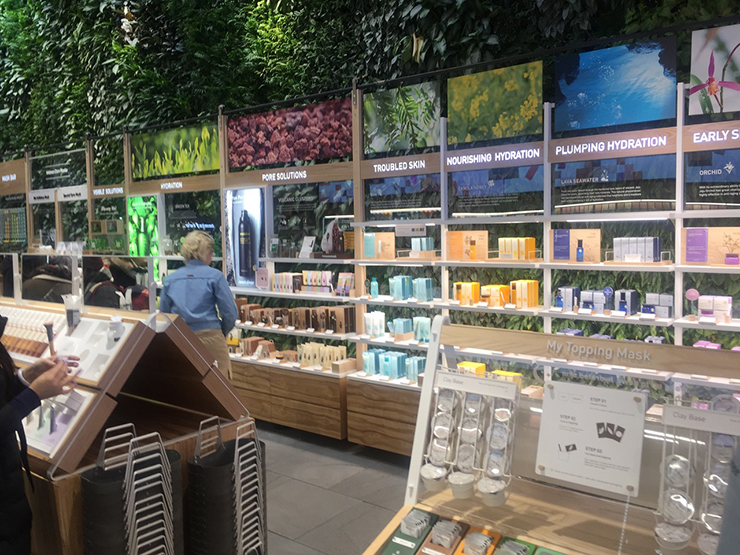
The Innisfree shop in Union Square has a 21 foot living plant wall.
. . . . . . . . . . . .
Innisfree, a highly touted Korean beauty company, has a wide and customizable range of specialty sheet masks. If you’d like to explore them, they’re available at the recently opened Innisfree Western Hemisphere beachhead, in the Union Square area. For starters, try the Fermented Soybean Bio Cellulose Mask, whose antioxidant-rich soybeans are said to be extra-potent. What’s more, the mask material is a nano-fiber that promises a precise fit to the contours of each face.
The Lip Slip, $28 at SaraHapp.com. Are your lips as bedeviled as mine from the cold wind and steam heat? And do you, like me, find that just about every pomade is a mere hour-long fix? Here’s an exception: the Sara Happ Lip Slip, a nice, thick balm with staying power—part of a lip-care-exclusive product line developed by an ESPN journalist-turned-beauty entrepreneur in her Los Angeles kitchen. I now smooth on Lip Slip overnight, every night and over my lipstick by day. And while I find myself reflexively biting my lips, expecting chapping, it’s gone—no doubt due to the beeswax and jojoba and macadamia seed oils contained therein.

Linda Dyett’s articles on fashion, beauty, health, home design, and architecture have appeared in The New York Times, Washington Post, Monocle, Afar, New York magazine, Allure, Travel & Leisure, and many other publications.
You may enjoy other NYCitywoman articles by Linda Dyett:
The Latest in Makeup: Think Little or None
Turning Antique Lace into Silver and Gold
Tips from a Top NYC Hair Colorist
A Makeup Update for Mature Faces
A Look at Five Visionary Studio Jewelers
Five More Visionary Studio Jewelers











